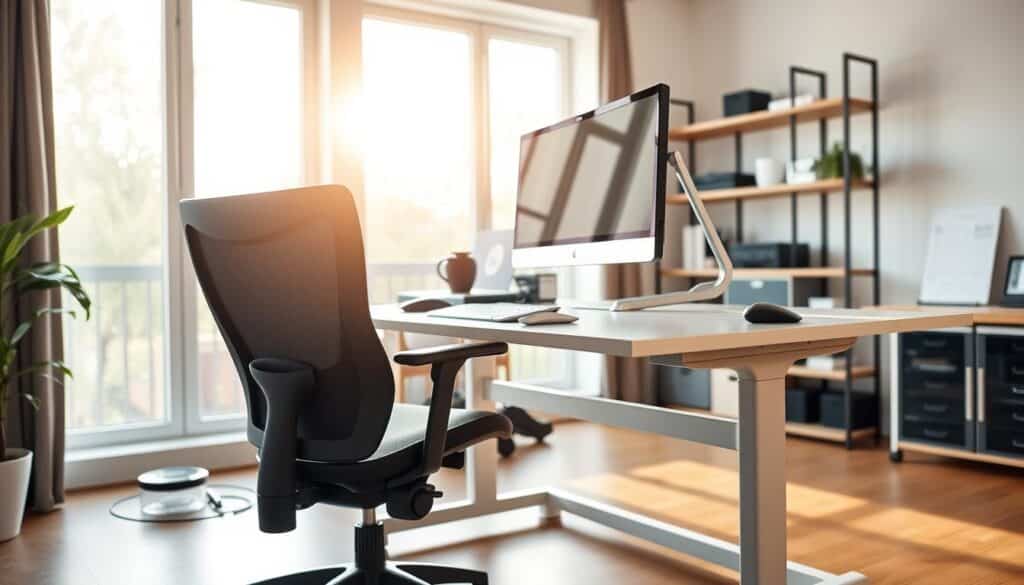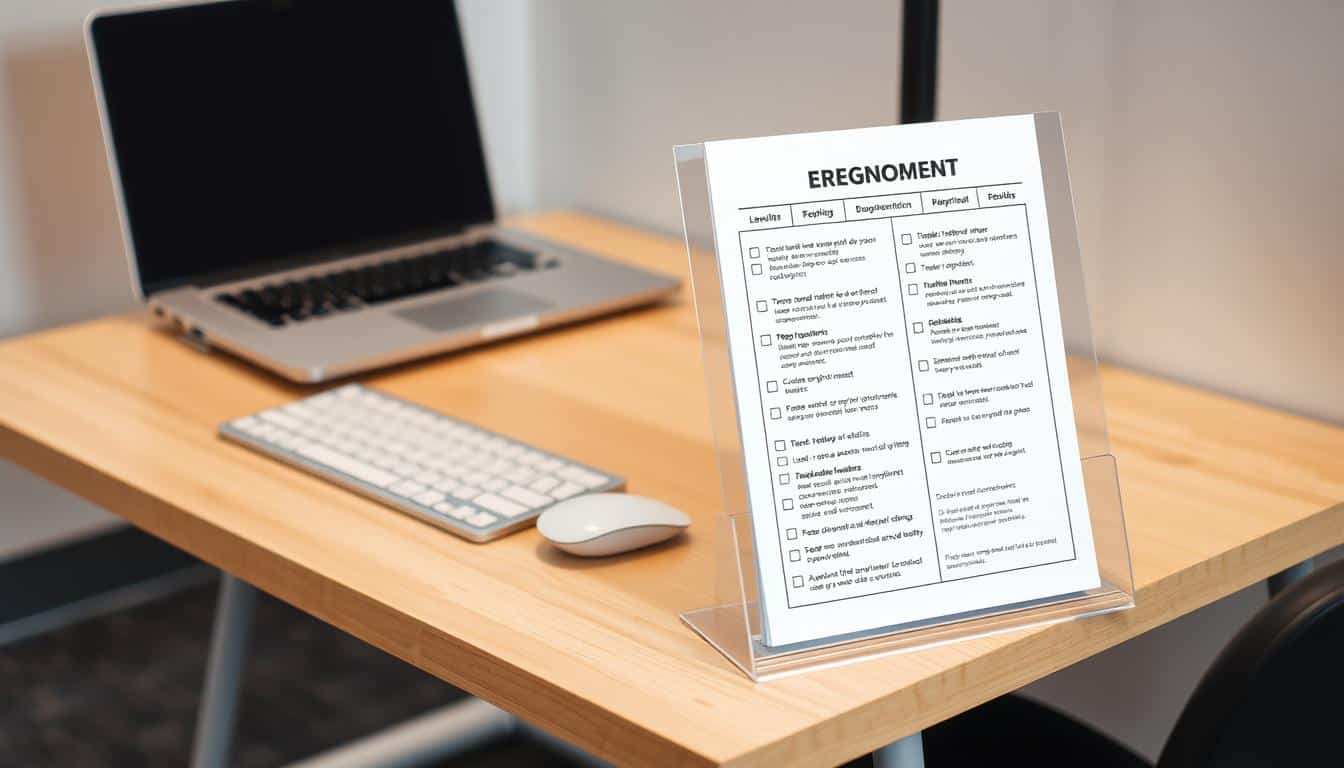In our fast-moving world, more people work from home, making a couch their office. This comfy spot can cause bad posture and slouching. This affects work and health. To solve this, it’s key to use ergonomic solutions. This creates a better work space at home. Experts, like those from Mayo Clinic, tell us how important a good setup is.
Understanding Ergonomics in Home Workstations
Ergonomics makes workspaces fit our needs at home. It aims to create comfy and efficient spaces. Good home workstation ergonomics boost work output and lower injury risks from long sitting times.
For a great work-from-home setup, picking the right ergonomic furniture is key. Items like adjustable chairs and desks help keep our bodies properly aligned. This eases discomfort, which is common in regular setups. The Mayo Clinic also points out the long-term health perks of choosing ergonomic furniture.

Applying ergonomic principles means more than just a good chair. It’s about having your desk and computer monitor set up right. This keeps your neck and eyes from straining. Such setups make working from home both healthier and more effective.
The Dangers of Slouching While Working
Slouching at work does more harm than just feeling uncomfortable. It can cause lasting back pain and serious neck problems. This bad habit can lead to risks that some people don’t think about until they face health issues.
Some people call it the “sitting disease.” It comes from sitting the wrong way for too long. Studies show that a lot of work-related injuries are because of bad posture. That shows how key it is to sit right at your job.
Not sitting straight can make you more likely to get different health problems. Making small changes, like how you sit and using ergonomic chairs, can cut down these risks. Being active in preventing slouching can greatly boost your health.
Identifying Signs of Poor Posture
Knowing how to spot bad posture helps you stay healthy and comfy, especially if you sit a lot for work. Pain in your neck, stiff shoulders, and lower back discomfort are key signs. These signals mean your body is telling you your posture needs work.
Listening to your body’s warnings is key for good posture. Often, people ignore these small signs, leading to bigger problems later. Try to notice how you sit and feel while working. Check in with yourself often, ensuring you’re comfortable and well-aligned.
Watch out for these red flags:
- Persistent neck pain or shoulder tension.
- Lower back pain that gets worse with long periods of sitting.
- Feeling tired or unable to concentrate on your work.
Recognizing and responding to these signs early can help you improve your desk setup. This prevents bad posture issues. Make it a habit to notice how you feel while working to keep your body happy and healthy.
Benefits of an Ergonomic Couch Workstation
Turning your couch into an ergonomic workstation can offer big benefits. Being comfortable helps boost productivity. It allows people to work longer without feeling bad because of sitting wrong.
Studies by health groups show that ergonomic setups can make you healthier. Choosing an ergonomic couch workstation means better posture and less chance of pain from sitting too much.
Some notable benefits include:
- Increased productivity through enhanced focus and reduced distractions.
- Improved overall health by decreasing strain on the back and neck.
- Fostering a more relaxed work environment, leading to creative thinking and problem-solving.
Many don’t realize how great a smart workspace can be, even if it’s just on a couch. Using ergonomic rules, you can make working space healthier and more effective.
How to Choose the Right Couch for Work
Picking the right couch for work is key to staying comfy and productive. An ergonomic couch makes a big difference in how you feel. It’s important to have enough support for your lower back. This helps keep your spine straight and prevents discomfort and health problems down the line.
Keep these points in mind when choosing a work couch:
- Supportive Backrest: Go for couches that have curved backrests. They should match your spine’s natural curve.
- Appropriate Seat Height: Your couch should be the right height so your feet can touch the floor. This helps with a proper ergonomic setup.
- Seat Depth: Look for a couch that lets you sit up straight without slouching. The seat depth should help with this.
- Material Quality: Choose upholstery that’s breathable and comfy for long hours of use.
Think about different couch styles for your office. Some couches, like sectionals or ones with adjustable features, might fit your work needs better. By considering these factors, you’ll create a workspace that keeps you in good posture all day.
Slouching Fix for Couch Workstation
Fixing slouching starts with adjusting how you sit. Small changes can improve your posture and make working healthier. By adopting these easy habits, you’ll work more productively and feel better too.
Adjust Your Seating Position
For a better workspace, keep your feet flat on the ground. This helps with alignment and eases strain. Your back needs good support to stay upright all day. You might need to find an adjustable chair that fits you just right.
Utilize Cushions for Support
Ergonomic cushions boost comfort when you’re working long hours. Lumbar support pillows fit your spine’s curve to prevent slouching. Just adding these pillows can really improve how you sit and work.
Essential Accessories for Couch Workstations
For a comfy couch workstation, you need the right accessories. Lumbar support pillows and footrests are key for better posture. They make you more productive and keep you feeling good.
Lumbar Support Pillows
Lumbar support pillows follow your spine’s curve, giving your lower back the support it needs. This stops you from slouching while working on the couch. A good lumbar support pillow greatly improves your comfort when you work for hours.
Footrests for Better Posture
Footrests keep your feet grounded and support better posture. They take the pressure off your legs, by letting you adjust how you sit. This means less fatigue and more focus on work, without feeling uncomfortable.
Best Practices for Maintaining Good Posture
Working on a couch requires keeping good posture to avoid discomfort and health issues. Adding proper ergonomics tips can make sitting much better. Making small changes helps fix your posture.
Consider these best practices:
- Take breaks often to stand and stretch. This helps muscles relax and reset.
- Do posture checks during the day. Make sure your back is straight and shoulders are at ease.
- Keep your legs uncrossed to prevent your hips and spine from getting out of line.
- Set your monitor so the top is level with your eyes or a bit lower.
- Use cushions or support pillows for your back’s natural curve.
- Try to switch between sitting and standing. Use a standing desk or tall table for changes.
Being mindful of how you sit at work can cut down on the pain from sitting too long. Using these easy tips not only makes you more comfortable but also helps you work better.
Incorporating Movement into Your Work Routine
Adding movement to your work routine is key for staying healthy, especially if you sit a lot. Taking breaks from your desk helps lessen pain and makes you more alert and productive. Studies show that pausing for a bit every 30 minutes can improve blood flow and energy, fighting off the tiredness from sitting too long.
Here are easy ways to move more during your day:
- Set a timer for every 30 minutes to remind yourself to stand up and stretch.
- Walk around your workspace or home when you take breaks.
- Suggest walking meetings to keep moving even during discussions.
These easy tips can help make your workday more active. Mixing stretching and walking helps fix any discomfort from poor posture. Making time for movement is great for your body and mind, and is a must for a balanced work life.
Conclusion
In summary, talking about ergonomic solutions shines a light on the need for a good workspace setup. This is especially true for people who use their couch for work. Knowing how important proper posture is cannot be stressed enough. It affects both comfort and how well you work. By choosing the right furniture and adding supportive items, people can make a workspace that helps them stay focused and healthy.
Also, it’s very important to follow the best posture practices to avoid the dangers of slouching. By moving carefully and keeping the body aligned, individuals can improve their work experience and long-term health. As we end this article, remember that getting ergonomic solutions is essential. It’s not just a trend, but a crucial step for a healthier and more efficient work life.



